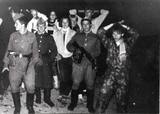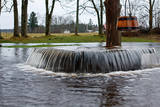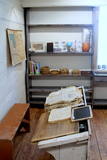| Nr | Name | Beschreibung |
|---|---|---|
|
This is the only viewing platform of its kind. It is north of Pāvilosta, between the sea and Latvia’s largest gray dune. The second level of the platform offers a good view of the habitats which surround the dune, as well as the seashore and the largest seashore rock on the shores of the Baltic Sea – the Pāvilosta sea rock. You can also see the northern part of Pāvilosta. When it is windy outside, you’ll see kiteboard riders showing their tricks.
|
||
|
Das Gutsschloss wurde im 17. – 18. Jh. im Barockstil gebaut. In den 20er Jahren des 19. Jh. wurde es im Stil des Klassizismus umgebaut. In der Zeit zwischem dem Ende des 17. Jh. bis zum 20. Jh. war das größte Landgut Estlands. Hotel, Restaurant, Konferenzzentrm, Museum. |
||
|
1,2 km gara taka, kas pa purvainu mežu aizved līdz Ērdi purvam (Öördi raba) un tā austrumu daļā esošajam Ērdi ezeram (Öördi järv), pie kura izveidota atpūtas un peldvieta. |
||
|
Der Elkas kalna-Bauernhof befindet sich auf dem malerischen Hügel Elka – dort, wo der Fluss Gauja beginnt. Kräutertees, Birkensaft, Marmeladen und sonstige gesunde Leckereien aus lokalen Wiesen- und Gartenpflanzen. Es werden auch Natur-Werkstätten und Picknicks im Freien angeboten. |
||
|
The Soviet Border Guard arrived at Lapmežciems (its border with Ragaciems) in the mid-1960s and left in 1991. Some 50 military personnel were stationed here. The military personnel and local residents organised various events and celebrations. The only thing that worried locals was a radar which was said to cause various problems. The zenith missiles were dismantled and taken away in 1991. An apartment building is still on what was then the military base. |
||
|
Zentrum traditioneller Handwerke, besonders in der Pflege der Traditionen des Töpferhandwerks mit jährlichen Ferienlagern und Töpferkursen für Kinder, Ausstellungen der Erzeugnisse. außerdem gibt es Kurse zum Thema traditioneller Feste. |
||
|
Atrodas Tērvetes ziemeļrietumu daļā, Tērvetes upītes krasta līkumā. „Sprīdīšos” sava mūža pēdējo desmitgadi (no 1922. līdz 1933. g.) strādāja un atpūtās latviešu rakstniece Anna Brigadere (1861. - 1933). Šajā laikā top lugas, stāsti, dzejoļi un rakstnieces atmiņu triloģija. No laukakmeņiem celtā „Sprīdīšu” ēka uzbūvēta 1840 g. Te sākotnēji darbojušās ūdensdzirnavas, tad skola, dzīvojuši mežziņi. Tagad šeit aplūkojams rakstnieces memoriālais muzejs. No „Sprīdīšiem” var uzsākt garāku pastaigu pa Tērvetes dabas parku, kur izvietoti no koka darinātie A. Brigaderes pasaku varoņi. |
||
|
Einzigartiger Themenpark am Fluss Pirita, wo sich alles um die alten Wikinger dreht. Leistungen: Wikingerburg, Zauberstube, Schmiede, prähistorische Kampfspiele, Schauspiele, Abenteuerreisen mit Wikingerboot auf dem Fluss Pirita, Wanderungen mit Einbaumboot, Wurfwaffen, Bogenschiessen, Axtwerfen, Höhlensauna, Rauchsauna, Forellenfang, Erlebnisunterkunft, Verpflegung u.a. |
||
|
Pirmā ir uzcelta uz vienstāvīgā apmeklētāju centra jumta. No tās paveras plašs skats uz Kīdevas ciemu, ostu un niedrēm apaugušo Matsalu līča ziemeļdaļu. Austrumos no šīs atrodas vēl viena - divstāvīga putnu vērošanas platforma. No Kīdevas līdz Puisei gar Matsalu līča var doties pārgājienā pa 5 km garo dabas taku. To izejot, novēroto putnu sugu klāsts noteikti būs lielāks! |
||
|
Atrodas ceļa, kas ved uz Miķeļtorņa bāku – līkuma malā. Unikālā ēka (vienīgais lībiešu ciemu krogs ar raksturīgo plānojumu, kas saglabājies līdz mūsdienām) šobrīd atrodas avārijas stāvoklī un apskatāma tikai no ārpuses. Pizes krogs celts 1853. gadā. |
||
|
The recently renovated viewing tower offers a wonderful view of the impressive and forested ancient Gauja River valley. The Gūdu cliffs are visible. This is part of the Līgatne nature trails territory, where there are wide paddocks of wild animals.
|
||
|
Kaziņmežs (Ziegenwald) – ein kleines Waldmasiv das sich im Osten von der
Kreuzung der Strassen Mazirbe-Cirste und Kolka-Ventspils befindet. Ein
sagenumwogener Platz. Wenn man durch den Ziegenwald geht, kommt man an
der Kreuzung der Strasse Kolka-Ventspils (P 124) raus.
|
||
|
The craftswoman is prepared to offer practical activities which allow you to learn about clay, use a potter’s wheel, and release your inner creative abilities. After the firing of the products in a kiln, you will be able to take them along as a fine souvenir which confirms our newly discovered skills. The craftswoman also grows herbs and teas which you can sample. |
||
|
Takas sākums atrodas Vidagā, vietā, kur uz Vizlas celts vēsturiskais akmens arkas tilts. 1,2 km garā taka bez marķējuma ved gar pašu upes krastu līdz pat ietekai Gaujā. Redzami skaisti dolomīta atsegumi, nelieli krāčveidīgi ūdenskritumi un iespaidīgais Žākļu dižakmens. |
||
|
An impressive two-trunk tree at the Nigliņi homestead, this is one of the most impressive trees on the Liv Shore. The Liv language teacher Zoja Sīle was born here. The Medieval Old Cemetery Hill – once used as burial grounds – is nearby. |
||
|
Gas mixture is the main raw material for Estonia’s energy and chemical industries, and it is extracted in our day from open quarries or underground shafts. This layer was established during the Ordovician Period between 450 and 480 million years ago, and it is made up of the remnants of plants and animals from that age. In the Kohtla-Nõmme suburb, there is a shaft which can be toured in the company of a guide who will tell you that this is the only layer of its kind in the Baltic States. He will tell you about how the gas mixture has been extracted over the course of history.
|
||
|
The historical centre of Talsi, which is known as the town of nine hillocks. The historical construction around Baznīckalns hill, Lake Talsi and Lake Vilkmuiža mostly dates back to the 19th century. Lielā Street is particularly beautiful with its low-rise buildings (two or three floors and ridged roofs). There are beautiful views from the area around Lake Talsi and Ķēniņkalns hill. |
||
|
Dieser Biergarten befindet sich gegenüber der Brauerei Brenguļi, wo das Bier (ungefiltertes, nicht pasteurisiertes) nach dem Wissen der Vorfahren aus den Getreidekörnern gebraut wird, die von den lokalen Bauern gezüchtet worden sind. Im Biergarten kann man das helle und das dunkle Bier von Brenguļi kaufen, sowie lettische Speisen genießen. Lettische Küche: Graue Erbsen mit Speck, Würste mit Kraut, Eis von Rujiena. |
||
|
Die Anlage des Parks begann zu Beginn des 19. Jahrhunderts als Landschaftspark mit vielen Spazierwegen, Bänken und Brücken. Gegenwärtig ist der Park Kazdanga der Fläche nach (196 ha) einer der größten und zudem einer der aus dendrologischer Sicht reichhaltigsten Parks in Lettland. Hier wachsen über 200 Arten Gehölze, davon 127 fremdländische. Der Park zieht sich durch das gesamte Dorf Kazdanga, einschließlich des Gutshofs, bis hin zu der Stelle wo sich nördlich davon die Krypta der Familie von Manteuffel befindet. Der Bau dieser Krypta wurde mit Beginn des 1. Weltkriegs abgebrochen. Im Park gibt es mehrere Rastplätze und viele dekorative Elemente. Das Schloss Kazdanga wurde um 1800 erbaut. Der Entwurf stammte von dem in Europa bekannten Architekten Johann Georg Berlitz, wobei er auf ein Projekt von Giacomo Quarenghi zurückgriff. Das Schlossensemble besteht außerdem aus dem Ritterhaus, dem Gesindehaus, dem Wohnhaus, Marstall, der dreibögigen Brücke, die über eine Schlucht führt, und weiteren Gebäuden. 1922 wurde hier eine Landwirtschaftsschule eröffnet. Heute gibt es hier das Schlossmuseum und unweit davon das Touristeninformationszentrum. |
||
|
The space is on the second floor of the Jūrkalne library, featuring traditional objects from Jūrkalne and the Suiti people, as well as several looms where locals organise creative workshops. Contact the chamber in advance to arrange for a guide who will tell you all about the culture and traditions of the Suiti and present a film about them. |
||























